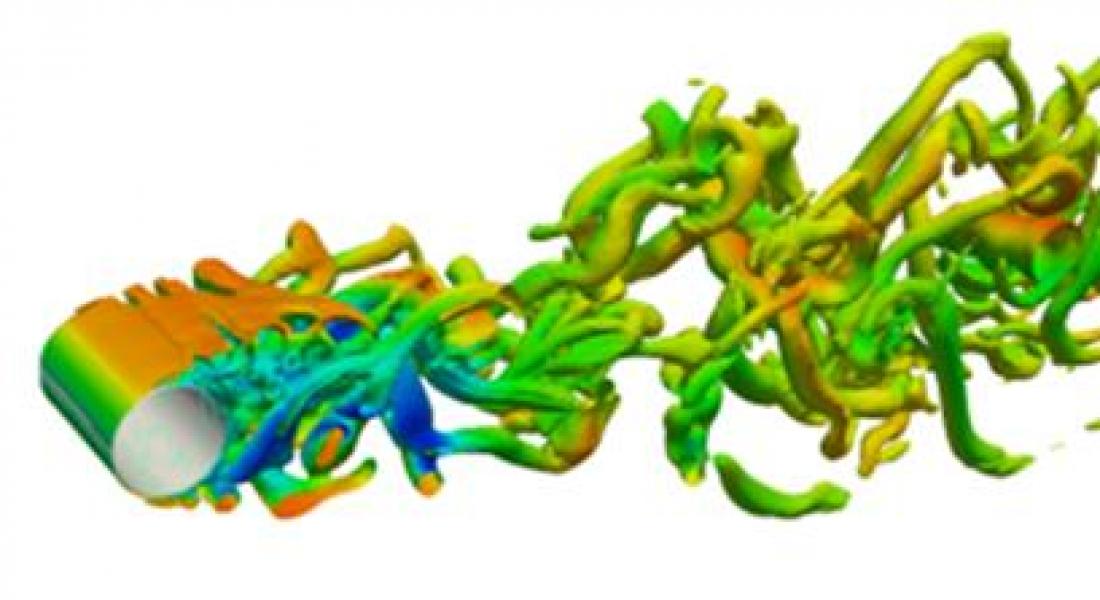Three-dimensional vortex structures observed in the wake of a cylinder; imposing unsteady hydrodynamic loadings on structure. Such analyses can be employed to optimise new ship designs.
MEDIA RELEASE
FOR IMMEDIATE RELEASE
21 JANUARY 2015
NEW PUBLIC PRIVATE COLLABORATION AIMS TO DEVELOP MORE EFFICIENT AND ECO-FRIENDLY SHIPS
A*STAR’s Institute of High Performance Computing (IHPC), Sembcorp Marine Ltd, University of Glasgow and University of Glasgow Singapore (UGS) will join hands to improve the design of large ocean-going vessels
Singapore — A new research collaboration between A*STAR’s IHPC, Sembcorp Marine Ltd, University of Glasgow and UGS aims to make a ship’s voyage more smooth sailing by improving its hydrodynamics and energy efficiency.
The four organisations today signed a memorandum of understanding (MoU) to collaborate and develop new hull designs for large ocean-going vessels and make them more environmentally friendly.
Under the three-year MoU, IHPC, Sembcorp Marine Ltd, University of Glasgow and UGS will use computational modelling and visualisation technologies to design vessels with improved hydrodynamics for better fuel efficiency. In addition, they will collaborate and innovate on features to reduce harmful exhaust emissions and discharges by enhancing the vessel’s scrubber and ballast treatment systems. Currently, maritime transport carries about 90 percent of all international trade and accounts for three percent of global greenhouse gas emissions.
Under this research collaboration, Sembcorp Marine and IHPC will analyse and improve gas abatement technology, using an enhanced scrubber design to address the emission of harmful gases like sulphur oxides (SOx), nitrous oxides (NOx), particulate matter and greenhouse gases, in particular CO2, from the ship’s heavy fossil fuel burning combustion engines. Such designs and technology are also needed to meet the International Maritime Organization’s new 2015 standards on ship-related air pollutants and marine environmental issues.
The partnership will form an eco-system that creates value from unique technologies and research talent. The collaboration will employ multi-physics computation to build modelling and simulation capabilities. It will combine the scientific expertise from IHPC, University of Glasgow and UGS, with Sembcorp Marine’s knowledge and wealth of experience in industrial maritime applications.
IHPC has developed significant maritime-related computational R&D capability in areas such as fatigue prediction for enhanced structural integrity, marine corrosion prevention, efficient gas flow emission control, hull optimisation, and integrated risk assessment of assets using the analytics of condition monitoring. IHPC will also draw upon its industrial R&D experience from its marine and offshore industry collaborations with partners such as Lloyd’s Register and the Southampton Marine and Maritime Institute.
As part of talent training and development, University of Glasgow and UGS will provide academic training and certification to students, who are staff of Sembcorp Marine, under the Industrial Postgraduate Programme. This will be complemented by IHPC’s use of applied R&D to develop the students’ capabilities, which they can then apply to sharpen Sembcorp Marine’s competitive technological edge.
“IHPC acts as a catalyst that translates research into practical applications. By harnessing the power of computational modelling and simulations, we help shipbuilders optimise design to improve efficiency and environmental sustainability of large commercial vessels. This can significantly impact the way ships are built and accelerate the advancement of more fuel-efficient and greener vessels,” said Prof Alfred Huan, Executive Director of A*STAR’s IHPC.
Mr Ong Poh Kwee, Deputy President of Sembcorp Marine Ltd., “This collaboration is a major step towards combining innovative ideas in science and technology with maritime experience to develop products and processes which are in demand by maritime and on-shore industries. Such a collaboration will contribute towards better efficiency in ships, reducing gas emission and enhance the marine ecology”.
“As a world top 100 University, whose School of Engineering was recently rated in the top five in the UK-wide assessment of university research - the Research Excellence Framework - this collaboration represents a tremendous opportunity to demonstrate the reach and impact of our research. Our new partnership with A*STAR’s Institute of High Performance Computing and Sembcorp will innovate in the design of new ships’ hulls with the aim of improving the efficiency of large ocean-going vessels and reducing greenhouse emissions. The initiative not only highlights the increasing importance of multi-centre, cross disciplinary research in overcoming the significant challenges that exist in developing new environmentally-sustainable shipping technologies but also demonstrates the huge benefits for both the public and private sector in working together,” said Prof Jonathan Cooper, Vice Principal for Innovation and Knowledge Exchange at University of Glasgow.
“To achieve innovation, it is increasingly important for industry, research centres and academia to collaborate with each other. By leveraging on the capabilities from all partners, we can accelerate the innovation necessary to bring next-generation technologies in eco-shipping to the marine and offshore sector, quickly and cost-effectively. This partnership also provides a unique opportunity for our students to gain early exposure to the real-world of industrial engineering,” said Prof Gianmarco Radice, Director of UGS.
Beyond the current areas of focus, the three organisations hope to expand the scope of the collaboration to create a more comprehensive package of solutions for more efficient ocean-going vessels. The partners are also looking at the possibility of a joint laboratory to advance R&D in this area.
For media queries and clarifications, please contact:
Eugene Low
Senior Manager, Corporate Communications
Agency for Science, Technology and Research
Tel: +65 6874 8491
Email: [email protected]
________________________________________
About A*STAR’s Institute of High Performance Computing (IHPC)
A*STAR’s Institute of High Performance Computing (IHPC) was established in August 1998 to provide leadership in high performance computing as a strategic resource for scientific inquiry and industry development. It seeks to power discoveries through advanced methodologies, techniques and new tools in modelling, simulation and visualisation. Its core research areas are in the realm of complex-coupled systems, mechanics and fluid dynamics, large-scale systems, digital modelling, adaptive and collaborative computing, data mining and analysis, computational electronics and electromagnetics, computational materials science and chemistry. For more information about IHPC, please visit www.ihpc.a-star.edu.sg.
About the Agency for Science, Technology and Research (A*STAR)
The Agency for Science, Technology and Research (A*STAR) is Singapore's lead public sector agency that fosters world-class scientific research and talent to drive economic growth and transform Singapore into a vibrant knowledge-based and innovation driven economy. In line with its mission-oriented mandate, A*STAR spearheads research and development in fields that are essential to growing Singapore’s manufacturing sector and catalysing new growth industries. A*STAR supports these economic clusters by providing intellectual, human and industrial capital to its partners in industry. A*STAR oversees 18 biomedical sciences and physical sciences and engineering research entities, located in Biopolis and Fusionopolis, as well as their vicinity. These two R&D hubs house a bustling and diverse community of local and international research scientists and engineers from A*STAR’s research entities as well as a growing number of corporate laboratories. For more information on A*STAR, please visit www.a-star.edu.sg.
About Sembcorp Marine Ltd
Sembcorp Marine is a leading global marine and offshore engineering group with more than 50 years of experience and proven capabilities in repair, specialised shipbuilding, building of high-specification jack-up rigs, fast track construction of ultra-deepwater semisubmersible rigs, conversion of floating production and storage facilities as well as the engineering and construction of offshore platforms. Headquartered in Singapore, it has a network of six shipyards in Singapore – Jurong Shipyard, Sembawang Shipyard, SMOE, PPL Shipyard, Jurong SML and the new Sembmarine Integrated Yard @ Tuas, which commenced operations in August 2013. Beyond Singapore, the Group has strategic operations in Indonesia, China, India, Brazil, United Kingdom and USA. For more information about Sembcorp Marine, please visit www.sembmarine.com
About University of Glasgow
The University of Glasgow has been inspiring people to change the world for over 550 years and is a member of the prestigious Russell Group of leading UK research universities. As a world top 100 university with annual research income of more than £181m and overall student satisfaction rate of 91%, the University of Glasgow is committed to delivering world class research at the same time as the highest standards of teaching and education. The University’s Boyd Orr Centre for Population and Ecosystem Health was awarded the Queen's Anniversary Prize for Higher and Further Education last year.
ANNEX A
Project highlights and details
1) Importance of shipping in international trade
International shipping transports about 90 per cent of global trade to peoples and communities all over the world. Shipping is the most efficient and cost-effective method of international transportation for most goods; it provides a dependable, low-cost means of transporting goods globally, facilitating commerce and helping to create prosperity among nations and peoples.
2) Environmental regulations as one of the key drivers in shipping
• The International Convention for the Prevention of Pollution from Ships, also known as MARPOL, and adopted by the IMO seeks to limit the main air pollutants contained in the exhaust gas of ships such as sulphur oxides (SOx), nitrous oxides (NOx), particulate matter (PM) and greenhouse gases (in particular CO2), as well as ballast water management.
• New international regulations related to ships’ energy efficiency began in January 1, 2013, while stricter sulphur requirements will enter into force for specific sea areas in 2015 and globally in 2020, with ballast water treatment requirements expected to enter into force before the middle of the decade.
3) Purpose of MoU
University of Glasgow / UGS (academic) – The research intensive university engages in human capital development e.g. Industrial Postgraduate Programme (IPP) programme, to build a pool of researchers with critical R&D skills for industry. The MoU allows University of Glasgow and UGS to strengthen the purpose and usefulness of the IPP programme/human capital development programme, enhances the value of academic training with industry-perspective research, and allows students the opportunity to apply the knowledge acquired in a practical setting.
IHPC (catalyst) – IHPC takes on the role of an enabler or catalyst, to collaborate with partners across the value chain to translate research into impactful industry applications. IHPC will collaborate with University of Glasgow and UGS in talent development, work with Sembcorp Marine to enhance the competitiveness of industry, and improve productivity through innovation. IHPC’s expertise in computational modelling and simulation can help to review and visualise complex structures as well as analyse and address design challenges during the design phase, shorten time to market and achieve greater productivity gains.
Sembcorp Marine (industry application) – Sembcorp Marine collaborates with research performers to develop new technologies in order to capitalise on the shipping trends (i.e. the IMO environmental regulations). The MoU brings about value creation by developing proprietary systems that can potentially deliver game changing technologies to stay ahead in competition. Sembcorp Marine will provide real world infrastructure and testbedding facilities to complement research activities and technology development.
(1) Source: International Maritime Organization, http://www.imo.org/OurWork/TechnicalCooperation
/ITCP/Pages/Default.aspx
(2) Source: “Maritime transport: first step to reduce emissions”, European Commission press release, http://europa.eu/rapid/press-release_IP-13-622_en.htm
(3) Source: International Maritime Organization, http://www.imo.org/About
(4) Source: International Maritime Organization, http://www.imo.org/OurWork/Environment/Documents/IMO%20and%20the%20Envir...




